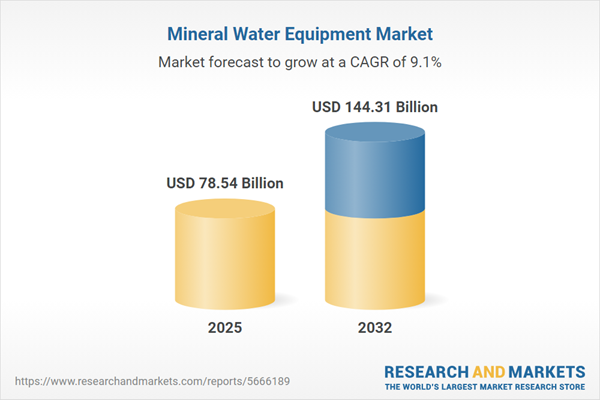Speak directly to the analyst to clarify any post sales queries you may have.
Senior executives in the mineral water equipment market face transformative pressures from rapid regulatory, technological, and sustainability changes. Keeping pace with these dynamics is critical, as organizations must balance efficiency, compliance, and adaptability to secure long-term growth and resilience.
Market Snapshot: Mineral Water Equipment Market Growth and Outlook
The mineral water equipment market is experiencing significant expansion, with a current value of USD 72.05 billion projected for 2024. Analysts expect further progression to USD 78.54 billion in 2025, with long-term forecasts predicting a rise to USD 144.31 billion by 2032. This translates into a robust compound annual growth rate (CAGR) of 9.06%. The growth trajectory is powered by stricter regulatory frameworks governing both equipment and water quality, widespread adoption of automated production and packaging solutions, and a sharpened focus on sustainable operations. To remain competitive, businesses are streamlining manufacturing and supply processes in line with evolving industry standards and consumer expectations, while next-generation technologies promote higher efficiency, compliance, and responsible resource management.
Scope & Segmentation: Mineral Water Equipment Market Analysis
- Product Type: Encompasses manual, semi-automatic, and fully automatic filling lines, empowering companies to match equipment capabilities to operational scale and efficiency goals.
- Capping Technology: Features crown, flip top, and screw closure systems, ensuring compatibility with a wide array of packaging types and adherence to regional standards for safety and quality.
- Labeling and Washing Systems: Implements modular technologies that increase traceability, safeguard brands, and help businesses maintain hygiene standards in line with current regulations.
- Packaging Flexibility: Offers options including carton boxing and shrink wrapping, which enable adaptable logistics and address varied customer and market needs.
- Operation Type: Spans a range of machine formats—automated, semi-automatic, and manual—allowing organizations to scale production efficiently and adapt to changing market demand.
- End Use: Serves both large-scale bottlers and smaller operations, supporting the entire spectrum of organizations with compliance and productivity advancements.
- Water Type: Systems are engineered for both still and sparkling mineral water, enabling portfolio diversification and broader market reach, including emerging and established regions.
- Distribution Channel: Covers direct sales, distributor networks, and online platforms, providing organizations with procurement flexibility across global regions.
- Capacity: Solutions range from less than 1,000 to over 5,000 bottles per hour, accommodating operations from niche producers to high-volume manufacturers.
- Regional Coverage: Includes North America, Latin America, Europe, Middle East & Africa, and Asia-Pacific, allowing stakeholders to adjust to diverse regulatory landscapes, digitalization paces, and consumer preferences.
- Key Companies Covered: Leading players such as Krones Aktiengesellschaft, Sidel S.p.A., Tetra Pak International S.A., GEA Group Aktiengesellschaft, KHS GmbH, SIPA S.p.A., SIG Combibloc Group AG, Robert Bosch Packaging Technology GmbH, SPX FLOW Inc., and Sacmi Packaging & Automation S.p.A. are advancing technology and product innovation across the sector.
Key Takeaways: Strategic Insights for Mineral Water Equipment Market Decision-Makers
- Deploying modular automation and IoT monitoring increases transparency and enables proactive maintenance, ensuring smooth production line operations while supporting optimized resource allocation.
- Stringent washing and sterilization integrate into supply chains, reinforcing compliance while supporting operational reliability for premium and private-label water brands.
- Frequent upgrades to capping and labeling platforms let producers align with evolving packaging and sustainability standards across global markets.
- Developing strong local supplier and service partnerships mitigates operational risk through improved access to replacement parts and rapid technical support.
- Investments in scalable, flexible equipment infrastructures provide agility, letting organizations quickly respond to changes in product requirements or shifts in consumer demand.
Tariff Impact: Navigating Trade Policy Developments
Recent U.S. tariff adjustments are prompting manufacturers to diversify their supply chains, balance sourcing strategies, and develop flexible procurement practices. By emphasizing domestic manufacturing or expanding supplier networks internationally, organizations reduce their exposure to policy-driven volatility and sustain supply reliability through changing trade environments.
Methodology & Data Sources
This analysis integrates insights from executive interviews, comprehensive industry reviews, and assessment of regulatory frameworks. The research is further enhanced by trade statistics and scenario planning using SWOT analysis, yielding a well-rounded and validated market perspective.
Why This Report Matters
- Senior leaders receive practical, action-oriented guidance for refining procurement, investment, and digital transformation strategies aligned with ongoing shifts in industry standards.
- Frameworks outlined in the report support market entry and growth initiatives across varied geographies, while strengthening compliance management and fostering innovation.
- Decision-makers gain access to risk mitigation strategies that help maintain operational continuity amid dynamic sector trends.
Conclusion
By prioritizing automation, adopting adaptable technologies, and engaging reliable local partners, organizations position themselves to achieve resilience and sustainable advancement within the mineral water equipment market.
Additional Product Information:
- Purchase of this report includes 1 year online access with quarterly updates.
- This report can be updated on request. Please contact our Customer Experience team using the Ask a Question widget on our website.
Table of Contents
3. Executive Summary
4. Market Overview
7. Cumulative Impact of Artificial Intelligence 2025
Companies Mentioned
The companies profiled in this Mineral Water Equipment market report include:- Krones Aktiengesellschaft
- Sidel S.p.A.
- Tetra Pak International S.A.
- GEA Group Aktiengesellschaft
- KHS GmbH
- SIPA S.p.A.
- SIG Combibloc Group AG
- Robert Bosch Packaging Technology GmbH
- SPX FLOW, Inc.
- Sacmi Packaging & Automation S.p.A.
Table Information
| Report Attribute | Details |
|---|---|
| No. of Pages | 195 |
| Published | October 2025 |
| Forecast Period | 2025 - 2032 |
| Estimated Market Value ( USD | $ 78.54 Billion |
| Forecasted Market Value ( USD | $ 144.31 Billion |
| Compound Annual Growth Rate | 9.0% |
| Regions Covered | Global |
| No. of Companies Mentioned | 11 |









